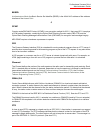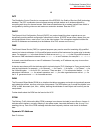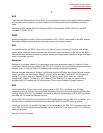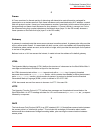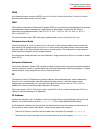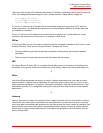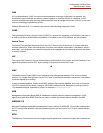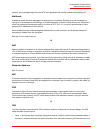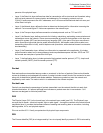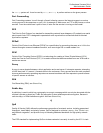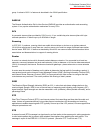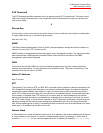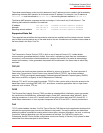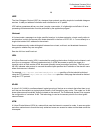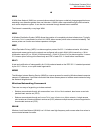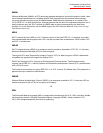
Professional Access Point
Administrator Guide
Glossary - 315
ponents of the physical layer.
• Layer 2, the Data-Link layer, defines how data for transmission will be structured and formatted, along
with low-level protocols for communication and addressing. For example, protocols such as
CSMA/CA and components like MAC addresses, and Frames are all defined and dealt with as a part
of the Data-Link layer.
• Layer 3, the Network layer, defines the how to determine the best path for information traversing the
network. Packets and logical IP Addresses operate on the network layer.
• Layer 4, the Transport layer, defines connection oriented protocols such as TCP and UDP.
• Layer 5, the Session layer, defines protocols for initiating, maintaining, and ending communication and
transactions across the network. Some common examples of protocols that operate on this layer are
network file system (NFS) and structured query language (SQL). Also part of this layer are communi-
cation flows like single mode (device sends information bulk), half-duplex mode (devices take turns
transmitting information in bulk), and full-duplex mode (interactive, where devices transmit and receive
simultaneously).
• Layer 6, the Presentation layer, defines how information is presented to the application. It includes
meta-information about how to encrypt/decrypt and compress/decompress the data. JPEG and TIFF
file formats are examples of protocols at this layer.
• Layer 7, the Application layer, includes protocols like hypertext transfer protocol (HTTP), simple mail
transfer protocol (SMTP), and file transfer protocol (FTP).
P
Packet
Data and media are transmitted among nodes on a network in the form of packets. Data and multimedia
content is divided up and packaged into packets. A packet includes a small chunk of the content to be sent
along with its destination address and sender address. Packets are pushed out onto the network and
inspected by each node. The node to which it is addressed is the ultimate recipient.
Packet Loss
Packet Loss describes the percentage of packets transmitted over the network that did not reach their
intended destination. A 0 percent package loss indicates no packets were lost in transmission. QoS
features are designed to minimize packet loss.
PHY
The Physical Layer (PHY) is the lowest layer in the network layer model (see OSI). The Physical Layer
conveys the bit stream - electrical impulse, light or radio signal -- through the network at the electrical and
mechanical level. It provides the hardware means of sending and receiving data on a medium, including
defining cables, NICs, and physical aspects.
Ethernet and the 802.11 family are protocols with physical layer components.
PID
The Process Identifier (PID) is an integer used by Linux to uniquely identify a process. A PID is returned by



